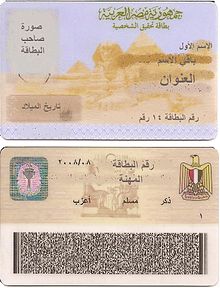Egyptian National Identity Card

National Identity Card, officially known as the Identity Verification Card in Egypt, is a personal identification document issued by the Civil Registry Authority, which operates under the jurisdiction of the Egyptian Ministry of Interior. The card serves as identifying Egyptian citizens, in compliance with Law No. 143 of 1994 on Civil Status.
This law mandates that all citizens aged 16 and above obtain and carry the identity card and present it to public authorities upon request. Failure to acquire the card, update personal data within three months of any changes, or present the card when requested by public officials may result in a fine.
The validity period of the National Identity Card is determined by a decree from the Minister of the Interior, currently set at seven years from the date of issuance.[1] Once this period expires, the card becomes invalid.[2]
Card data
[edit]The card contains the following information:
- Name
- Birth date
- Gender (Options: Male | Female)
- Religion (Options: Muslim | Christian | Jewish | "-" for non-religious or other)[3]
- Residence Address
- Issuing office[4]
- Profession (As per the relevant registration certificate, depending on applicable laws such as the University Organization Law, the Trade Union Law, the Civil Service Law for the government sector, the Labor Law for the private sector, etc.[5]
- Husband's name (for women)
- National number
- Personal photo
- Card issuance date
- Card expiration date (for cards issued after January 1, 2009)[6]
- Card number (printed number)
National Number
[edit]The national number is a unique 14-digit identifier assigned to each citizen. It encodes specific personal information and remains linked to the individual throughout their lifetime.[7]
- First Digit from the Left: Represents the century of birth.
- Next Six Digits: Represent the date of birth.
- Next Two Digits: Represent the province of birth.
- Next Four Digits: Serve as a serial number.
- Last Digit: An optional check digit used to verify the validity of the national number.
Note: The province of birth number is assigned by the civil registry computer, along with the serial number and confirmation number. The back of the card is printed with an optical code that complies with the PDF417 standard, and the encoded data is encrypted.
National ID description
[edit]Each citizen's national number represents the following:
| Examples | 7 | 9 | 5 | 4 | 0 | 3 | 1 | 5 | 1 | 8 | 0 | 2 | 8 | 2 |
|---|---|---|---|---|---|---|---|---|---|---|---|---|---|---|
| Code | C1 | Z1 | Z | Z | Z | X | X | D | D | M | M | Y | Y | C |
| Description | Check digit
verification number (check digit) |
Unique Four-Digit Number:
A number assigned by the system that is distinct for births occurring on the same day within the same province. |
Province Code:
Denotes the specific province of birth. |
Date of birth | Denotes the century of birth,
representing a span of one hundred years. Starting from 1900 to 1999 = C = 2 Starting from 2000 to 2099 = c = 3 | |||||||||
| Odd Number:
Indicates that the baby is male. Even Number: Indicates that the baby is female. |
Day | Month | year | |||||||||||
Provincial codes
[edit]| Code | 01 | 02 | 03 | 04 | 11 | 12 | 13 | 14 | 15 | 16 | 17 | 18 | 19 | 21 |
|---|---|---|---|---|---|---|---|---|---|---|---|---|---|---|
| Governorate | Cairo | Alexandria | Port Said | Suez | Damietta | Dakahlia | Sharqia | Qalyubia | Kafr El Sheikh | Gharbia | Monufia | Beheira | Ismailia | Giza |
| Code | 22 | 23 | 24 | 25 | 26 | 27 | 28 | 29 | 31 | 32 | 33 | 34 | 35 | 88 |
| Governorate | Beni Suef | Fayoum | Minya | Asyut | Sohag | Qena | Aswan | Luxor | Red Sea | New Valley | Matruh | North Sinai | South Sinai | Outside the republic |
See also
[edit]References
[edit]- ^ Interior: Renewal of national ID cards from 97 to 2001, Masrawy, December 21, 2008 Archived April 30, 2012, at the Wayback Machine.
- ^ In accordance with Articles 78 and 50 of Law No. 143 of 1994 on Civil Status.
- ^ According to the amendment of Decree No. 1121 of 1995, which issued the executive regulations of the Civil Status Law.
- ^ https://books.google.com.eg/books/about/%D9%82%D8%B1%D8%A7%D8%B1_%D9%88%D8%B2%D9%8A%D8%B1_%D8%A7%D9%84%D8%AF%D8%A7%D8%AE%D9%84%D9%8A%D8%A9_%D8%B1%D9%82.html?id=DPR5QgAACAAJ&redir_esc=y Decree No. 1121 of 1995, which promulgates the executive regulations of the Civil Status Law, specifically refers to Article 34.
- ^ In accordance with Article 33 of Decree No. 1121 of 1995, which issues the executive regulations of the Civil Status Law.
- ^ In accordance with Sections 1 and 2 of Minister of Interior Decree No. 1723 of 2008.
- ^ In accordance with Sections 1, 2, and 3 of Decree No. 1121 of 1995, which issues the Executive Regulations of the Civil Status Law.
External links
[edit]- National ID card, Egyptian Consulate website
- Interior Ministry clarifies what the code number on the back of the national ID is - Ahram Gate - June 16, 2011
